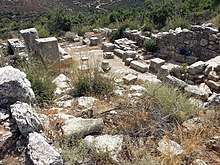Khirbet Shema
Khirbet Shema[1] is an archaeological site located in Israel at the foot of Mount Meron. (32 degrees, 58' 38" N. & 35 degrees, 26' 21" E.)

The site
It is the traditional burial site of Shammai,[2] a contemporary and opponent of Hillel the Elder.
Several researchers have identified the site with the ancient Tekoa of Galilee, although no evidence has been discovered to verify this interpretation. American archaeologist Eric M. Meyers excavated the site from 1970 to 1972 on behalf of the American Schools of Oriental Research.
Excavations have uncovered a large mausoleum, numerous tombs and an old synagogue. Additionally, their work included "uncovering adjacent buildings and surrounding parts of the village."[3] The area recovered exceeded six acres.
Even by 1974, having worked with up to 80 people, no remnants of the synagogue's roof were found.
Analysis
Researchers have reviewed the "coins, glass, plaster, ceramic stone, bone, jewelry and some organic materials" found. Although "over 4,000 artifacts have been found in the excavations,"[3] there is little evidence of late Hellenistic colonization and the end of Roman times at the site.
The team's Co-head, Dr. James F. Strange, professor of biblical archeology at University of South Florida,[4] indicated that the ruins of the synagogue show it to be unique, both for the area and time of construction. "There were several factors which led us to believe the building was quite unlike any other synagogue in that part of Palestine."[3] Specific features he found noteworthy included "foundation walls .. nearly two feet thick, .. an entrance staircase .. stairs ten feet wide ... and a number of underground chambers."
The bulk of the coins[5] suggest that this area was populated from 180 to around 417 CE, when "the village was destroyed by .. an earthquake."
Shape of the building
Excavations done in "different sites in upper Galilee: Shema, Meiron, Gush Halav and Nabratein"[6] helped uncover more information about the debate as to "whether the earliest Galilean synagogues .. were built on a so-called basilical plan[7] .. as opposed to a broad building" known as "a broadhouse plan."[8] Khirbet Shema and two other ancient synagogues excavated around the same time all were broadhouse.
Bibliography
- Robert J. Bull, "Khirbet Shema", in: Israel Exploration Journal, 20: 232-34, 1970
- Robert J. Bull, "Khirbet Shema", in: American Journal of Archaeology, 75: 196-97, 1971
- Jodi Magness, "Synagogue Typology and Earthquake Chronology at Khirbet Shema ', Israel", in: Journal of Field Archeology, 24: 211-20, 1997
- Eric M. Meyers:
- "Horvat Shema ', the Settlement and the Synagogue", in: Qadmoniot, 5, 2: 58-61, 1972
- Ancient Synagogue Excavations at Khirbet Shema, Upper Galilee, Israel, 1970–72,[9] Cambridge: American Schools of Oriental Research, 1976[10]
- "Ancient Synagogues in Galilee: Their Religious and Cultural Significance", in: Biblical Archaeologist, 43, 2: 97-108, 1980
- With James F. Strange, Archeology, the Rabbis, and Early Christianity, Nashville: Abingdon, 1981
- "Stratigraphic and Ceramic Observations from the Medieval Strata of Khirbet Shema, Israel:
- Assessment of the Value of Scientific Analysis", in: Bulletin of the American Schools of Oriental Research (en), 260: 61-69, 1985
Additional reading
Books
- Ancient Synagogue Excavations at Khirbet Shema', Upper Galilee, Israel 1970-72. (Annual of the American Schools of Oriental Research 42). Durham: Duke University Press, 1976. By A. Thomas Kraabel (With E.M. Meyers and J.F. Strange).
Articles
- "Khirbet Shema' et Meiron." (A. Thomas Kraabel) Revue biblique 80 (1973) 585-587 + P.. 34f.
- "Khirbet Shema' and Meiron." (A. Thomas Kraabel, With E. M. Meyers and J. F. Strange). Israel Exploration Journal 22 (1972) 174-176 + PI. 37f.
References
- or Khirbat Shema
- (who died in 30 CE)
- {{cite magazine |magazine=[[Communications of the ACM (Association for Computing Machinery) |url=http://www.bitsavers.org/pdf/modernData/Modern_Data_1974_01.pdf |title=The Synagogue of Khirbet Shema Restored |date=February 1974 |page=A4}}
- "James F. Strange USF Dean to speak at Brunch". The Jewish Floridian of Pinellas County. April 18, 1986. p. 9.
- one person, Prof. Richard Simon Hanson, was the site's numismatist. "Ancient Numismatics Collection".
coins unearthed at Khirbet Shema, ... he was the numismatist
- Eric M. Meyers; Carol L. Meyers (1981). "Finders of a Real Lost Ark".
- (longer, walking in, than wide)
- such as Eshtemoa synagogue: "13.3 m (44 ft) by 21.3 m (70 ft) .. Entry by any of three doors along its eastern side ..
- Eric M. Meyers (1976). Ancient Synagogue Excavations at Khirbet Shema, Upper Galilee, Israel, 1970-1972. ISBN 0822303779.
- "Ancient Synagogue Excavations at Khirbet Shema, Upper Galilee, Israel". SemanticScholar.org. 1976.
This wiki article started as a machine (google) translation of https://fr.wikipedia.org/wiki/Khirbat_Shema (French), but also with information from CACM (English, Feb. 1974, "Synagogue of Khirbet Shema Restored").
External links
On other Wikimedia projects:
- Khirbat Shema , on Wikimedia Commons
- (en) "Khirbat Shema" , creighton.edu site
- Archeology portal
- Portal Ancient Israel and Jews in Antiquity